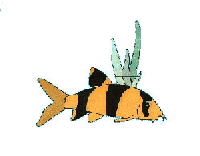ASHTABULA COUNTY AQUARIUM CLUB


Brislenose Pleco
Ancistrus dolichopterus

ASHCO
BAP Report
Dawn Cryberg
Another article on the art of spawning and raising the fish known
as the brislenose pleco.
The first spawning was noticed by sheer accident. We were
removing most of the plants (hornworth, water sprite, Java moss) for an
auction. Since I was already disturbing the tank inmates and I could not
remember when I had changed the water last, I decided to siphon off some
gravel, 1/5 of the water and rearrange the tank. Well, in the rearranging
the slate I pick up a soft piece of slate. Now wait a minute, slate is
not soft so I brought the slate out of the tank for closer examination.
Well here were about 100 yellow mustard seed size eggs in a pile on the
slate. "Ah, one of the fish has spawned" I yelled happily to my husband.
Of course he asks the obvious question - "which ones." Well the choices
were many. Here's the litany : clown loaches- fish too small, corys - wrong
color eggs, koolie loaches - eggs too big, zebras - they scatter their
eggs, neons - no way, Kribs - no they had there spawn swimming with them
and so on until we got to the plecos. The real clincher was the hollowed
out belly on the wiskerless 3" pleco. The whiskered pleco kept circling
the place the eggs had been. Another sure sign of responsibility.
Well now that we had the eggs, what were we
going to do with them? All we had available was a fish less 5 gallon bare
bottom tank with water pH below 6, air hose bubbling, and heat about 78-82
degrees F. A quick read of a FISH BOOK revealed that the eggs took 7-9
day to develop. These eggs hatched in 3 days so papa pleco must have been
guarding them well in the community hodgepodge tank. When they hatched,
they had a very large egg sac that took about 4-5 days to be absorbed.
They grew rapidly up to the first 1/2 inch on Dorogreen and zucchini oatmeal
mixture. Then they seem to add girth and length slowly even while eating
ravenously.
OBSERVATION OF REPEATED SPAWNS:|
Tank conditions:
Size: 55 gallon with very slow bubbling undergravel filters,
Temp: 70-75 degrees or hotter in the summer
Lighting: fluorescent light 8" over tank with one 40 watt
bulb timer varies from 8 hours to 18 hours
Plants: java moss on the bottom 1/4/ to 1/3 hornwort in
upper 1/4 to 1/3, and assorted other plants.
Gravel: standard tan aquarium about 3-4" deep
pH: ranged 7.4 to 6.4
Water changes: every few months since the 55 normally
only had 6 plecos, and 40 other small fish.
Food: Doragreen - about a stick per pleco occasionally
(when I remember to) frozen brine shrimp for the clowns.
Pair Behavior:
Since we wanted to save the eggs without having to search the tank
over, we gave the plecos 1" PVC tubes about 16" long. They seem to only
pay attention to the tubes when they were ready to spawn. The male will
mouth the tube clean. Then the miracle happens : the two plecos get into
the space that before only one had fit. The female lays the eggs and leaves
probably relieved to get out of the tight tube. The male will now put his
body over the eggs and fan then. The one problem that has come up as the
male has grown is that he and the eggs cannot fit in the tube and the eggs
get pulled out of the tube. The solution if you wanted the male to hatch
the eggs is a bigger tube.
Presently we have 18 adults in the 55 so the breeding pairs change,
with the largest oldest male usually fertilizing the eggs, unless he was
busy last night and is now tired. Then smaller males get the job.
There is no fighting among the males. no torn fins, nor pusking
to the far side of the tank. In fact they seem to cooperate in keeping
the egg-eating tankmates away from the egg mass. The defended territory
is only about 1-2 inches but they are very effective in keeping even the
clowns from eggs that have come away from the mass.
THERE GOOD POINTS:
They do not eat fertile eggs, their own or corys, at least these
plecos don't.
They do not grow over 5-6"
which is a reasonable size for most aquariums.
They can spawn at 3-5" so you can have many
breeding pairs, trios or or more in a reasionable size aquarium.
They keep the aquarium glass sparking
clean (maybe they can be trained to do windows!) The babys (or adults)
can be put in the tank with other types of baby fish to keep the glass
clean.
They do not root up planted
aquariums while they keep the plants clear of algee.
A tank of 200-300 pleco babys do not keep the tank churned up into
a cloud of debris like baby corys do.
THERE ONLY BAD POINT:
If they get very hungry, they will slowly dismantle a sponge filter
layer by layer until it is history.
Only one HEALTH PROBLEM has been observed. When the pH of the tank
goes below 5.5 the females get a bruised looking patch on there heads that
festers to the bone structure. A change of water, no medicine, and the
condition clears up in about two days.
All in all a nice, ugly, friendly, hardworking, peaseful fish.
ashco@usa.net

This page hosted by  Get your own Free Home Page
Get your own Free Home Page





